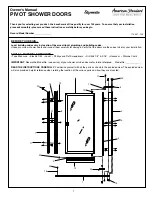
64
65
Caution: Make sure that the escape door can swivel
freely after the installation of the Pro cylinder EE.
Caution: The following figures show the installation
situation with standard door handles. The installa-
tion situations also apply to panic bars according to
DIN EN 1125 and for handles or push pads according
to DIN EN 179. However the order of installation re-
mains the same and must be adhered to under all
circumstances. The instructions must always be fol-
lowed. When in doubt, please contact the manufac-
turer.
Caution: After each installation, carry out a functio-
nal test. The inside knob must always return to its
neutral position on its own after being rotated (cam
flush; see Figure 34 on page 81). If you are using a
Pro cylinder EE without inside knob, you must test
the device when the outside knob is engaged.
Caution: Immediately after installation, a check
should be made as to whether the escape door lock
can be opened with a single hand movement in
every cylinder position (0-360°). In addition, always
observe the information provided by the lock and
fittings manufacturers.
INSTALLATION SITUATION
PRO CYLINDER EE
Caution: Prior to installation, you must ensure that
the inside knob of the Pro cylinder EE does not res-
trict the functioning of the panic bar (acc. to DIN EN
1125) or the handle (acc. to DIN EN 179). Make sure
there is enough space between the inside knob and
the panic bar / handle so that the panic bar / handle
can be activated completely and the door can be
unlocked with a single hand movement without
difficulty. Otherwise, you have to use a Pro cylinder
EE without inside knob. Always observe the infor-
mation provided by the respective lock and fittings
manufacturers.
Please note: The following figure shows the instal-
lation situation with panic bar according to DIN EN
1125. The installation situation also applies to the
door handle or push pads according to DIN EN 179.
A:
The spacing between the
panic bar and the inside knob
must be selected so as not to
restrict the functioning of the
panic bar or potentially crush
the fingers.
B:
This installation situation
requires the use of a Pro cylin-
der EE without inside knob.
Fig. 1: Example of panic bar
Proceed according to the installation sequence described and
observe the notes and figures.
Caution: For safety-relevant doors, the cylinder may
not protrude by more than 3 mm.
INSTALLATION
















































